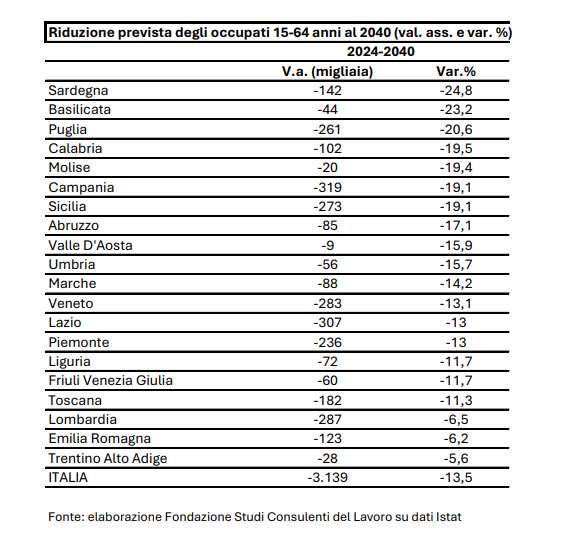By 2040 we will have 3 million less workers: the empty risk in the South. The map

The demographic decline will affect all Italian regions but in particular the south of the country. Basilicata will record the greatest decrease (8.1%) followed by Sardinia (7.8%) and Calabria (6.6%)
By 2040 Italy will have 3 million and 135 thousand less workers. This is what emerges from the report of the Foundation Studies Consultants of the Labor « to make the Sustainable demographic challenge », presented at the Labor Festival in Genoa. The population of active age will gradually disappear, between 15 and 64 years old, with A drop in one million 167 thousand units already at 2030.
Regional differences
With no small differences at regional level. With the exception of Lombardy and Emilia-Romagna, the drop in the population of work will touch all Italian regions. The South will be more interested: Basilicata the Region with the greatest decrease (8.1%), followed by Sardinia (7.8%), Calabria (6.6%), Puglia (6.4%), Campania and Sicily (6%). Values that will grow even more in 2040. Nuoro, Potenza, Enna (-9.7%), Caltanissetta (-9.6%), Oristano (-9.5%) Some of the provinces that will be more affected by the drop in employment.
Older workers
We will then have more elderly workers thanks to the raising of the threshold for retirement. Italy, compared to the European « colleagues » is the country with the highest incidence of Over 50 on the labor market (40.6% against 35.1% of the European average) and according to the Excelsior Unioncamere-Mystery of work, in the four-year period 2024-2028, the application for the replacement of workers who will retire will represent between 78% -88% of the overall needs of new profiles (corresponding to about 3 million).
The necessary investments
The decrease in the Neet, those who do not study and do not work, passed from 23.6% in 2019 to 17.3% in 2024, the inactive remain a rebus to be resolved: out of 12.4 million inactive between 15 and 64 years of age, registered by Istat, almost 6 million are less than 35 years old and about 7.9 million are women. For The President of the National Council of the Order of Labor Consultants, Rosario De Luca: « It is necessary to intervene on factors outside the market, such as welfare, training, gender and insertion policies to encourage participation in the work of these population bands ». In addition to creating adequate school-work transition paths, useful for simplifying entry into the labor market also for women. A first antidote to demographic winter.









